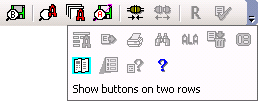Additional available options
The following table describes ways to customize other than using the options in the Tools > Options tabs.
| Customization | Options available |
|---|---|
| Fixed-field display (View > OCLC Fixed Field) |
Display fixed-length fields at the top or bottom of records or display as variable fields LDR, 001, 005, and 008. See Customize printing and display of records, lists, and labels for more information. |
| Import records – select record standard and character set (File > Import > Record Characteristics) |
Select record characteristics for imported records:
See Import bibliographic records (same procedure applies to authority records) for more information. |
| Keystroke shortcuts (Tools > Keymaps) |
A keymaps is a file of optional keystroke shortcuts for using menu commands, entering diacritics and special characters, inserting text strings, or running macros. The client supplies default keystrokes for commands and characters. Options for keystroke shortcuts include the following:
See Customize keystroke shortcuts for more information. |
| Local files (File > Local File Manager) |
The client provides local bibliographic and authority save files and local bibliographic and authority local constant data files. Authorization/password for local file Assign an authorization and password to use for interactive logon and batch processing when you use that particular local file. Default: None. The client uses the authorization/ password you set up in Tools > Options > Authorizations. See Assign an authorization/password to a local file for more information. Customize locations for local files The default location for Connexion client local files is X:\Documents and Settings\[user name]\Application Data\OCLC\Connex\Db, where X is the letter of your hard drive. The client creates default local files (with no data) in this location when you install the software. You can add other locations for local files, create multiple files, and change the default any time. See Add locations and create local files for more information. Automatic backup option for local files Select one of these options:
See Back up local files automatically for more information. Repair a file when you receive erroneous messages that records in a local file are in use by another (unlocks "stuck" records). |
| Macros (Tools > Macros) |
Write or edit macros (short computer programs) to automate routine tasks. Record macros automatically. Run, pause, or stop macros. Manage macro books (folders) that store macros. See Use Connexion client macros and List of Connexion client macro commands for more information. |
| Status bar, show or hide (View > Status Bar) |
Show or hide the status bar. See Main window for more information. |
| Text strings (Tools > Text Strings) |
Create text strings for often used data to insert in records (supplements constant data).
Alternatives:
Default: No text strings until you create one or more. See Create custom text strings for more information. |
| Toolbar, main client (Tools > Toolbar Editor) |
Add or remove toolbar buttons to customize the toolbar. Default: The client installs with preselected toolbar buttons (see Toolbars for more information). Reset toolbar to default button selection and order. See Customize the main client toolbar for more information. |
| Toolbar (main), display on one line or two (Option is available on the main client toolbar) |
Display the toolbar on one or two rows. Select one of the following in the toolbar drop-down list at the end of the toolbar to toggle between one row or two rows:
 See Toolbars for more information. |
| Toolbars, show or hide (View > Toolbars > Client or View > Toolbars > WorldCat Quick Search or View > Toolbars > Quick Tools) |
Show or hide:
Default: The client displays all toolbars
|
| User Profiles (Tools > Profiles) |
Create, select, or delete user profiles for changing to a different set of option settings and customizations. Use to switch between different sets of options and customizations (useful for cataloging for different libraries that require different settings) Default: The client provides default settings stored in X:\Users\[user name]\AppData\Roaming\OCLC\Connex\Profiles\MyProfile\ (X = letter of your hard drive) See Create multiple user profiles for options and customizations for more information. |
| User Tools (Tools > User Tools > Assign) |
Assign, unassign, view, or print up to ten generic User Tools. When assigned, use the command on the Tools menu or add the toolbar button to the toolbar. Or Avoid the menu/command and use the User Tools quick tool (  ) on the toolbar. In the drop-down list, click Manage. ) on the toolbar. In the drop-down list, click Manage.Assign tools to:
Customize default user tool descriptions that appear as tool tips and Tools > User Tool menu names. |
| WorldCat indexes (Cataloging > Search > WorldCat or Cataloging > Browse > WorldCat) |
For a guided search, choose from a short list (most used) or a comprehensive list of:
Display short list or comprehensive list using the  and and  buttons. buttons.For short lists (except languages), customize the list by adding, removing, or reorganizing indexes using the  button. button.See Customize WorldCat search and browse interfaces for more information. |
| WorldCat quick search toolbar (View > Toolbars > WorldCat Quick Search) |
Enter a WorldCat search or browse (index scan) in command line format directly in the toolbar without having to open the WorldCat Search window. See procedure in Use WorldCat quick search for command line searching. |
| WorldCat search results (Cataloging > Search > WorldCat > Settings) |
Set an option to determine the way WorldCat search results display:
Note: You can also toggle between list brief and truncated display using View > List Type > Brief [or Truncated]. See Customize WorldCat search and browse interfaces for more information. |

 ) on the toolbar.
) on the toolbar.